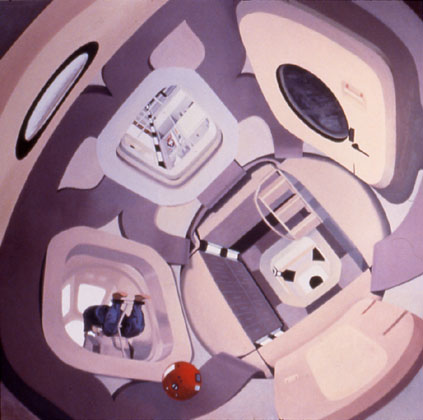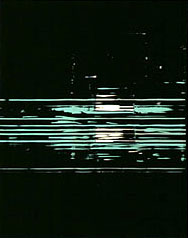View current page
...more recent posts
I was shocked--shocked--to learn of science fiction author Philip K. Dick's "treachery" toward his Marxist lit-crit champions, back in the '70s. According to an indignant article by Jett Heer in Lingua Franca, Dick received these people into his home, benefited from their insights into his work, and then ratted them out to the FBI! In a series of letters to the Bureau, Dick complained that critics Fredric Jameson, Peter Fitting, Richard Pinhas, and others were pressuring him to put Commie messages in his stories. The quoted letters are frankly hilarious, and as far as we know, led to no files being opened on these individuals. The article gives a few reasons why Dick might be paranoid (apparently the FBI tried to recruit him to spy on students in the '50s) but minimizes the fact that the letters were written during the most unsettled and drug-damaged period of his life. What's disturbing about the article is not Dick's "disloyalty" (he never asked the academics for their Marxist spin, or swore an oath to the Left)--it's the fickleness of the critics he supposedly "betrayed." After legitimizing his work with weighty-sounding observations about his "conception of reality[,] which mystifies the actual reality of the capitalist mode of production and the resultant repression and alienation," and so forth, a couple of them are now retracting their praise, on the grounds that he's not ideologically pure. Only fellow science fiction novelist Thomas Disch, who has written brilliantly about Dick (and was himself the subject of Dick's FBI correspondence), has the generosity to shrug off the episode, putting it in the proper context.
The picture below is from the home page of Mitsuki Ishinokami, a modern-day Giappetto bringing little-girl puppets to life. Although clearly geared to Japanese pedophilic fantasies, Ishinokami's pictures are amazing in their craftsmanship and ability to inspire paternal affection (I don't want to sleep with these girls, I just want to take them out for a Slurpee!). While Takashi Murakami's SUPERFLAT exhibition at LA MOCA dispenses early 21st Century, Modernist-friendly japonisme (the worst kind of patronizing colonialism, when you think about it), the work of Ishinokami and his fellow doll-makers falls squarely in the Western, Renaissance tradition of 3-D modeling and perspective; in fact, I'd go so far as to say it's kicking the collective ass of Pixar, ILM and other so-called state-of-the-art Hollywood shops. Think of the human kid in Toy Story--whose skin looks like pink felt and whose face is largely kept out of the frame--compared to the lifelike skin tones and expressive range of Ishinokami's creations. While still strangely robotic, the Japanese 3-D anime princesses (seen in Japanese magazines such as Virtual Beauty and websites such as Ishinokami's) are much more intriguing and "real" than Annanova, Lara Croft, and other cut-and-paste Western cyber-babes.
A quick overview of three shows I saw today:
Most embarrassing is probably Sean Landers at Andrea Rosen. A film critic said recently "You know a movie's in trouble when it includes a scene with one or more characters tied to a chair"; you could say the same about artists riffing on art history. Landers is doing big dumb Picasso paintings, with smeary impastos and monotonous cloisonne outlines around every facet and figure. I talked to a few of Landers' Yale-ophilic defenders, and they're justifying the show as "Sean coming to terms with the fact that he'll never be the biggest." Yuck. One thing it proves for sure, that's how much George Condo hurt his career by moving to Paris in the late '80s. If he'd stayed in New York those seven or eight years, channeling Picasso in show after show (as he did in Europe), even someone as oblivious as Landers would know how thoroughly "done" this strategy is.
I've been on the fence about Steve di Benedetto's work the past couple of shows; it's seemed overworked and fussy, not sure enough of what it's about. The new work at Baumgartner is good, though. Just when you think a painting couldn't get any more dense with organic, barnacle-like detail, suddenly a section opens up with a dynamic starburst or taut abstract fugue. The primordial octopus-from-another-dimension, which I felt he was hiding in earlier paintings, here unfurls its tentacles defiantly. The paintings nicely balance the gothic decrepitude of Ivan Albright with the futuristic energy of Matta, without being an overt homage to either.
Last, Rita McBride's show at Alexander & Bonin--at the opposite end of the form/content/materiality spectrum from di Benedetto's--is also top-notch. Very clean, mint green, geometric-looking sculptures are based on the exact outlines of arcade video games. No signage, no joysticks, just the stripped-down, squared-off essence of Xevious, Libble Rabble, and Ms. Pac Man (or so I imagine). I could see a recent UCLA graduate doing this sort of thing poorly, but McBride is a whiz with materials. The consoles, built entirely of porcelain-coated steel, have the blank-but-comforting surfaces of '50s refrigerators. The rest of the show--featuring other minimalist-type works modeled on awnings, HVAC vents, and parking garages--is good, but the video games really stand out.
New York painter Kara Hammond has a new show opening April 18 and running through May 16, 2001 at Joseph Rickards Gallery, 1045 Madison Avenue (between 79th/80th). She made her debut at Bronwyn Keenan Gallery a few years ago, and is known for her weirdly calm depictions of obsolete space technology, strip malls, and views from suburban freeways. The sense of charged emptiness in her paintings recalls Stanley Kubrick's cinematography: the image below could be Georgia O'Keeffe and Charles Sheeler trysting in the Pod Bay. This 4 x 4 foot, oil-on-wood piece is called Space Station, it's dated 2001, and remember you saw it here before it got reproduced in Time Out!

From a recent essay by William Gibson on Japan (and more particularly Anglo-Japanese cross-pollination, since the article's for The Guardian):
"I like to watch the Japanese in Portobello market. Some are there for the crowd, sightseeing, but others are there on specific, narrow-bandwidth, obsessional missions, hunting British military watches or Victorian corkscrews or Dinky Toys or Bakelite napkin rings. The dealers' eyes still brighten at the sight of a tight shoal of Japanese, significantly sans cameras, sweeping determinedly in with a translator in tow. A legacy from the affluent days of the bubble, perhaps, but still the Japanese are likely to buy, should they spot that one particular object of otaku desire. Not an impulse-buy, but the snapping of a trap set long ago, with great deliberation.
"The otaku, the passionate obsessive, the information age's embodiment of the connoisseur, more concerned with the accumulation of data than of objects, seems a natural crossover figure in today's interface of British and Japanese cultures. I see it in the eyes of the Portobello dealers, and in the eyes of the Japanese collectors: a perfectly calm train-spotter frenzy, murderous and sublime. Understanding otaku-hood, I think, is one of the keys to understanding the culture of the web. There is something profoundly post-national about it, extra-geographic. We are all curators, in the post-modern world, whether we want to be or not."
Dallas-based painter John Pomara has a show up right now at Inman Gallery in Houston, which has been getting some attention. Seems Pomara's former student Tad Griffin got known in Houston for a style and conceptual line somewhat similar to his, and the scene's so intimate that the idea of two artists mining the same vein makes people uncomfortable. Bill Davenport's review appears here, and my reply is here. Below is a jpeg of Pipeline, 2000, oil enamel on aluminum, 30 x 24 inches.

I just added an essay on the artist Michael Rodriguez to my website. Michael shows his work at Feature gallery and last year had a show of paintings at Miami-Dade Community College (he lives in New York, but originally hails from that part of the country). My essay and the images on the site are from the catalog published by the college. As you can see from what I wrote, and the reproductions (a detail of one of his acrylic-on-canvas paintings is below), we have some overlapping concerns as artists; more to the point, we have balls.
"There are no drum-machines, only rhythm synthesizers programming new intensities from white noise, frequencies, waveforms, altering sampled drum sounds into unrecognizable pitches. The drum-machine has never sounded like drums because it isn't percussion: it's electronic current, synthetic percussion, syncussion. The sampler is at first termed an 'emulator,' as if it does nothing but imitate existing sounds. Calling the rhythm synthesizer a drum-machine is yet one more example of [r]earview hearing. Every time decelerated media writes about snares, hihats, kickdrums, it faithfully hears backwards. Electro [e.g., Mantronix, Cybotron, Kraftwerk, Drexciya] ignores this vain hope of emulating drums, and instead programs rhythms from electricity, rhythmatic intensities which are unrecognizable as drums. There are no snares--just waveforms being altered. There are no bass drums---just attack velocities."
Excerpt from More Brilliant than the Sun, 1998, by Kodwo Eshun.
